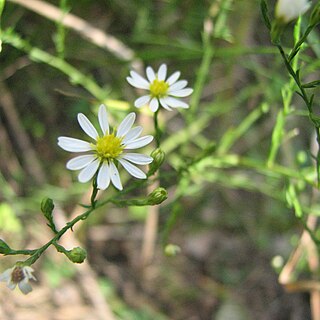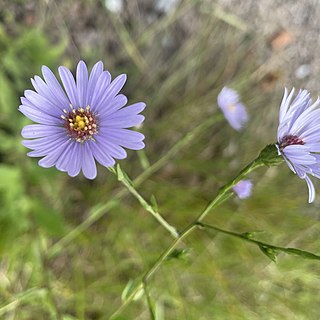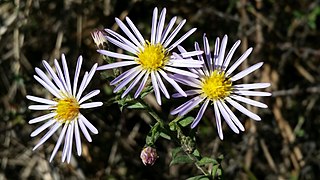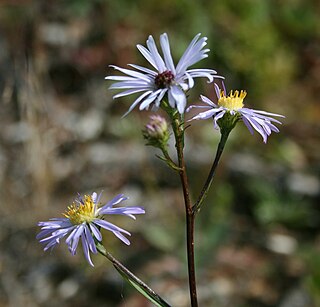
Symphyotrichum chilense is a species of flowering plant in the family Asteraceae known by the common names Pacific aster and common California aster. It is native to the west coast of North America from British Columbia to Southern California and the Channel Islands. It grows in many habitats, especially along the coast and in the coastal mountain ranges. Despite its scientific name, it does not occur in Chile. Pacific aster blooms from June to October with violet ray florets surrounding yellow disk florets.

Symphyotrichum sericeum is a species of flowering plant in the family Asteraceae native to central North America. Commonly known as western silver aster, western silvery aster, and silky aster, it is a perennial, herbaceous plant that may reach 70 centimeters tall. Its flowers have purple ray florets and pink then purple disk florets, and its leaves are firm and silvery-green.

Symphyotrichum defoliatum is a species of flowering plant in the family Asteraceae known by the common name San Bernardino aster. It is endemic to Southern California where it grows in grasslands and meadows, and it is of conservation concern.

Symphyotrichum eatonii is a species of aster known by the common name Eaton's aster. It is native to much of western North America from British Columbia to Saskatchewan, the Sierra Nevada in California, the Rocky Mountains region, to Arizona and New Mexico, where it grows in many habitats, especially wet areas such as meadows and near ditches. It is also known by the scientific name Symphyotrichum bracteolatum.

Symphyotrichum frondosum is a species of flowering plant in the family Asteraceae native to western North America. Commonly known as short-rayed alkali aster, it is an annual or perennial herbaceous plant that may reach 140 centimeters tall.

Symphyotrichum greatae is a species of flowering plant in the family Asteraceae endemic to California and known by the common name Greata's aster.

Symphyotrichum depauperatum, commonly known as serpentine aster or starved aster, is a rare species in the family Asteraceae adapted to serpentine barrens, an ecosystem with a high concentration of toxic metals in the soil. It has been found in Pennsylvania, Maryland, and on some diabase glades in North Carolina. It grows to 50 centimeters and has white ray florets surrounding a center of yellow disk florets.

Symphyotrichum lanceolatum is a species of flowering plant in the family Asteraceae native to North America. Common names include panicled aster, lance-leaved aster, and white panicled aster. It is a perennial, herbaceous plant that may reach 1.5 meters tall or more, sometimes approaching 2 m. The lance-shaped leaves are generally hairless but may feel slightly rough to the touch on the top because of tiny bristles. The flowers grow in clusters and branch in panicles. They have 16–50 white ray florets that are up to 14 millimeters long and sometimes tinged pink or purple. The flower centers consist of disk florets that begin as yellow and become purple as they mature.

Symphyotrichum prenanthoides is a species of flowering plant in the family Asteraceae known by the common name crookedstem aster. It is native to northcentral and northeastern North America.

Symphyotrichum rhiannon is a species of flowering plant endemic to a serpentine barren in western North Carolina. It has been given the vernacular Rhiannon's aster and is also known as Buck Creek aster. It is a perennial, herbaceous plant in the family Asteraceae.

Symphyotrichum fontinale is a species of flowering plant in the family Asteraceae endemic to Florida and a small area of southwest Georgia. It has the common names of Florida water aster and Florida water American-aster. S. fontinale is a perennial, herbaceous plant that may reach 30–90 centimeters in height.

Symphyotrichum turbinellum, with the common names of prairie aster, smooth violet prairie aster, and mauve-flowered starwort, is a species of perennial flowering plant in the family Asteraceae native to the United States in Arkansas, Illinois, Iowa, Kansas, Louisiana, Missouri, Nebraska, and Oklahoma, primarily in the Ozarks. It has gained the Royal Horticultural Society's Award of Garden Merit. It flowers from August to October.

Symphyotrichum jessicae is a species of flowering plant in the family Asteraceae endemic to Idaho and Washington states in the United States. Commonly known as Jessica's aster, it is a perennial, herbaceous plant that may reach 40 to 150 centimeters tall. Its flowers have violet ray florets and yellow disk florets. It is of conservation concern and known only from the Palouse River and Clearwater River drainages of eastern Washington and northwestern Idaho.

Symphyotrichum porteri is a species of flowering plant in the family Asteraceae endemic to the foothills of the Rocky Mountains in the U.S. states of Wyoming, Colorado, and New Mexico. Commonly known as Porter's aster, it is a perennial, herbaceous plant that may reach 10 to 50 centimeters tall. Its flowers have white, rarely pinkish, ray florets and yellow, becoming pink then brown, disk florets. S. porteri grows at elevations of 1,800–2,900 meters. Its limited range makes it a NatureServe Vulnerable (G3) species, and it is classified Critically Imperiled (S1) in Wyoming.

Symphyotrichum foliaceum is a species of flowering plant in the family Asteraceae native to western North America. Its common names are leafy aster, leafy-bracted aster, and alpine leafybract aster, and it is a perennial, herbaceous plant that may reach heights from 10 to 60 centimeters. Its flowers have violet to purple ray florets and yellow disk florets.

Symphyotrichum retroflexum is a species of flowering plant in the family Asteraceae native to the southeastern United States. Commonly known as rigid whitetop aster, it is a perennial, herbaceous plant that may reach 40 to 100 centimeters tall. Its flowers have blue to purple ray florets and cream to pale yellow then pinkish disk florets. It is known only from the Blue Ridge Mountains in Alabama, Georgia, North Carolina, South Carolina, Tennessee, and Virginia, where it grows in wooded areas at elevations of 400–1,500 meters. As of September 2021, NatureServe classified it as Apparently Secure (G4); it had been reviewed last in 1994 and is marked as "needs review". There is an introduced presence of S. retroflexum in southeast China.

Symphyotrichum hendersonii is a species of flowering plant in the family Asteraceae native to the northwestern United States. Commonly known as Henderson's aster, it is a perennial, herbaceous plant that may reach 70 to 150 centimeters tall. Its flowers have purple ray florets and yellow disk florets.

Symphyotrichum eulae is a species of flowering plant in the family Asteraceae endemic to Texas. Commonly known as Eula's aster, it is a perennial, herbaceous plant that may reach 5 to 150 centimeters in height. Its flowers have usually white to bluish or lavender-white ray florets and yellow then reddish to brown disk florets. It was named for Eula Whitehouse, American botanist, botanical illustrator, and plant collector.

Symphyotrichum chapmanii is a species of flowering plant in the family Asteraceae native to the Apalachicola River drainage basin of Alabama and Florida. Commonly known as savanna aster, it is a perennial, herbaceous plant that may reach 30 to 80 centimeters tall. Its flowers have purple to blue-lavender ray florets and pale yellow disk florets. It is a wetland species and is of conservation concern. It may be extirpated in Alabama.






















